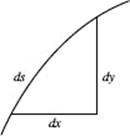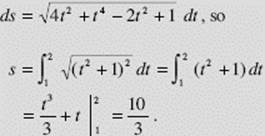Calculus AB and Calculus BC
CHAPTER 7 Applications of Integration to Geometry
C. ARC LENGTH
If the derivative of a function y = f (x) is continuous on the interval a ![]() x
x ![]() b, then the length s of the arc of the curve of y = f (x) from the point where x = a to the point where x = b is given by
b, then the length s of the arc of the curve of y = f (x) from the point where x = a to the point where x = b is given by

Here a small piece of the curve is equal approximately to ![]()
As Δx → 0, the sum of these pieces approaches the definite integral above.
If the derivative of the function x = g(y) is continuous on the interval c ≤ y ≤ d, then the length s of the arc from y = c to y = d is given by

If a curve is defined parametrically by the equations x = x(t) and y = y(t), if the derivatives of the functions x(t) and y(t) are continuous on |ta, tb], (and if the curve does not intersect itself), then the length of the arc from t = ta to t = tb is given by

BC ONLY
The parenthetical clause above is equivalent to the requirement that the curve is traced out just once as t varies from ta to tb.
As indicated in Equation (4), formulas (1), (2), and (3) can all be derived easily from the very simple relation
![]()
and can be remembered by visualizing Figure N7–21.

FIGURE N7–21
EXAMPLE 13
Find the length, to three decimal places, of the arc of y = x3/2 from x = 1 to x = 8.
SOLUTION: Here ![]()
EXAMPLE 14
Find the length, to three decimal places, of the curve (x − 2)2 = 4y3 from y = 0 to y = 1.
SOLUTION: Since x − 2 = 2y3/2 and ![]() Equation (2) above yields
Equation (2) above yields
![]()
EXAMPLE 15
The position (x, y) of a particle at time t is given parametrically by x = t2 and ![]() Find the distance the particle travels between t = 1 and t = 2.
Find the distance the particle travels between t = 1 and t = 2.
SOLUTION: We can use (4): ds2 = dx2 + dy2, where dx = 2 t dt and dy = (t2 − 1) dt. Thus,

BC ONLY
EXAMPLE 16
Find the length of the arc of y = ln sec x from x = 0 to ![]()
SOLUTION: 